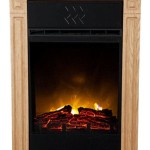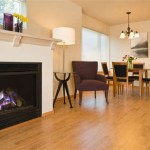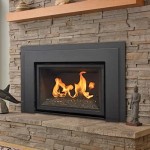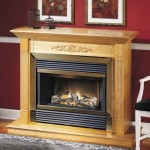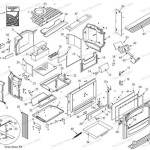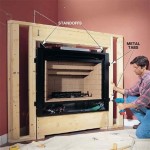Corner Fireplace Wood Stove Insert: A Comprehensive Guide
The integration of a wood stove insert into a corner fireplace presents a practical and aesthetically pleasing heating solution for many homes. This method allows homeowners to retain the existing fireplace structure while significantly improving heating efficiency and reducing emissions compared to traditional open fireplaces. A corner installation provides a unique space-saving advantage, maximizing room layout options. This article explores the key aspects of corner fireplace wood stove inserts, including factors to consider during selection, installation processes, and ongoing maintenance requirements.
A fireplace insert is essentially a self-contained wood stove designed to be placed inside an existing fireplace opening. Unlike open fireplaces, which lose a significant amount of heat up the chimney, wood stove inserts are engineered for efficient combustion and heat radiation. Corner fireplace inserts are specifically designed to fit neatly into the corner of a room, often with angled fireboxes and surround panels that complement the architectural features of the space. They can contribute to a more even distribution of heat throughout the room compared to a fireplace centered against a straight wall.
Key Considerations Before Purchasing a Corner Fireplace Wood Stove Insert
Before making a purchase, several crucial aspects must be assessed to ensure optimal performance and safety. These include measuring the existing fireplace opening, determining the appropriate heating capacity, and understanding local building codes and regulations.
Measuring the Fireplace Opening: Accurate measurements of the fireplace opening—height, width, and depth—are paramount. The insert must fit comfortably within the existing firebox, with adequate clearance for installation and proper ventilation. Manufacturers provide detailed specifications for each insert model, outlining the minimum dimensions required for installation. It is crucial to consult these specifications and measure the fireplace opening precisely, taking into account any irregularities in the brickwork or firebox construction. Additionally, the depth of the firebox is critical, as an insert that is too deep might protrude excessively into the room, while one that is too shallow may not provide adequate heating capacity. Careful measurements avoid costly mistakes and ensure a smooth installation process.
Determining Heating Capacity: The heating capacity of a wood stove insert is measured in British Thermal Units (BTUs). The BTU rating indicates the amount of heat the insert can generate per hour. The appropriate BTU rating depends on the size of the area to be heated, the insulation level of the home, and the climate in which the home is located. A larger, poorly insulated home in a colder climate will require an insert with a higher BTU rating than a smaller, well-insulated home in a warmer climate. Consulting with a qualified heating professional can help determine the optimal BTU rating for specific needs. An undersized insert will not adequately heat the space, while an oversized insert may lead to uncomfortable overheating and inefficient operation.
Understanding Local Building Codes and Regulations: Building codes and regulations governing the installation of wood-burning appliances vary significantly depending on location. These codes often address issues such as chimney requirements, clearance distances to combustible materials, and ventilation standards. Failure to comply with local building codes can result in fines, insurance complications, and potential safety hazards. Before purchasing and installing a corner fireplace wood stove insert, it is essential to contact the local building department to obtain the necessary permits and understand the specific requirements for the installation. A qualified professional installer will be familiar with local codes and can ensure that the installation complies with all applicable regulations.
The Installation Process of a Corner Fireplace Wood Stove Insert
The installation of a corner fireplace wood stove insert is a complex process that requires specialized knowledge and skills. It is generally recommended to hire a certified installer to ensure a safe and efficient installation. The installation process typically involves preparing the fireplace opening, installing a chimney liner, connecting the insert to the chimney, and installing the surround panels.
Preparing the Fireplace Opening: Before installing the insert, the fireplace opening must be thoroughly cleaned and inspected. Any loose bricks or mortar should be repaired or replaced. The firebox floor may need to be leveled to provide a stable base for the insert. If the existing fireplace has a damper, it should be removed or permanently sealed to prevent drafts and ensure proper chimney function. The chimney should also be inspected for any obstructions or damage. A professional chimney sweep can clean and inspect the chimney, ensuring that it is in good working condition.
Installing a Chimney Liner: A chimney liner is a metal pipe that is installed inside the existing chimney to provide a safe and efficient flue for the wood stove insert. The liner prevents the products of combustion from leaking into the house and protects the chimney from corrosion and deterioration. The liner should be sized appropriately for the insert and installed according to the manufacturer's instructions. The liner must extend from the insert's flue collar to the top of the chimney. Proper installation of the chimney liner is crucial for the safe and efficient operation of the wood stove insert.
Connecting the Insert to the Chimney: Once the chimney liner is installed, the wood stove insert can be connected to the chimney. This typically involves attaching a connector pipe from the insert's flue collar to the chimney liner. The connector pipe should be made of heavy-gauge steel and should be properly sealed to prevent leaks. The connection should be secure and airtight to ensure that all of the products of combustion are directed up the chimney. A professional installer will have the necessary tools and expertise to make this connection safely and correctly.
Installing the Surround Panels: Surround panels are metal or ceramic panels that are installed around the insert to cover the gap between the insert and the fireplace opening. The surround panels provide a finished look and help to direct heat into the room. The panels should be sized appropriately for the fireplace opening and installed according to the manufacturer's instructions. The surround panels should also be designed to allow for proper ventilation around the insert. A well-designed surround panel can enhance the appearance of the fireplace and improve the heating efficiency of the insert.
Maintaining a Corner Fireplace Wood Stove Insert
Regular maintenance is essential for ensuring the safe and efficient operation of a corner fireplace wood stove insert. Proper maintenance includes cleaning the chimney, removing ashes, and inspecting the insert for any signs of damage or wear.
Cleaning the Chimney: Regular chimney cleaning is crucial for preventing chimney fires. Creosote, a flammable byproduct of wood combustion, can build up inside the chimney over time. If enough creosote accumulates, it can ignite and cause a dangerous chimney fire. The frequency of chimney cleaning depends on the type of wood burned and the frequency of use. Generally, the chimney should be cleaned at least once a year, or more often if necessary. A professional chimney sweep can clean the chimney and inspect it for any damage or deterioration.
Removing Ashes: Ashes should be removed from the firebox regularly to maintain efficient combustion. A buildup of ashes can reduce airflow and make it more difficult to start and maintain a fire. Ashes should be removed when they reach a level of approximately two to three inches. Use a metal shovel and container to remove the ashes. Allow the ashes to cool completely before disposing of them. Ashes can be used as a fertilizer in the garden, but they should be spread thinly to avoid damaging plants.
Inspecting the Insert: Regularly inspect the wood stove insert for any signs of damage or wear. Check the door gasket for leaks, and replace it if necessary. Inspect the firebrick for cracks or damage, and replace any damaged firebrick. Check the chimney connector pipe for rust or deterioration, and replace it if necessary. Inspect the surround panels for any signs of warping or damage. Addressing any problems promptly can prevent more serious issues and extend the lifespan of the wood stove insert.
Considerations for wood selection include the wood's moisture content. Wood should be seasoned for at least six months, preferably longer, to reduce moisture content to below 20%. Burning wet wood creates more smoke and creosote, reducing efficiency and increasing the risk of chimney fires. Hardwoods, such as oak and maple, generally provide more heat per unit volume than softwoods, such as pine and fir. However, softwoods ignite more easily and can be useful for starting fires. A mixture of hardwoods and softwoods can provide a balance of heat output and ease of ignition. Avoid burning treated wood, painted wood, or other materials that can release harmful chemicals into the air.
In summary, corner fireplace wood stove inserts provide an efficient and aesthetically pleasing heating solution for many homes. The process requires careful consideration of fireplace dimensions, desired heating capacity, and adherence to local building codes. Correct installation and consistent maintenance are crucial for safety and effectiveness. With proper planning and execution, a corner fireplace wood stove insert can be a valuable addition to a home.

Hottest Snap Shots Corner Gas Fireplace Strategies Almost As Much All Of Us Protest Wi Stone Electric

3 Sided Fireplace Insert Instyle Ea Dik Geurts Double Corner Wood Burning

Superior Wood Fireplace Wrt4000 Wrt Wrc40cr Cl

Superior Wrt40 Custom Series Multi Sided Wood Burning Fireplaces

Are There Inserts For L Shaped Corner Fireplaces

Fireplaceinsert Com Vantage Hearth Corner Wood Fireplace

Sketch Of Corner Wood Burning Stove Functional And Interior Beautifier Stoves Living Room Log Burner

Flex 50rc Bxr Right Corner Fireplace Insert Ecosmart Fire

Flex 68lc Bx2 Left Corner Fireplace Insert Ecosmart Fire

Are There Inserts For L Shaped Corner Fireplaces


